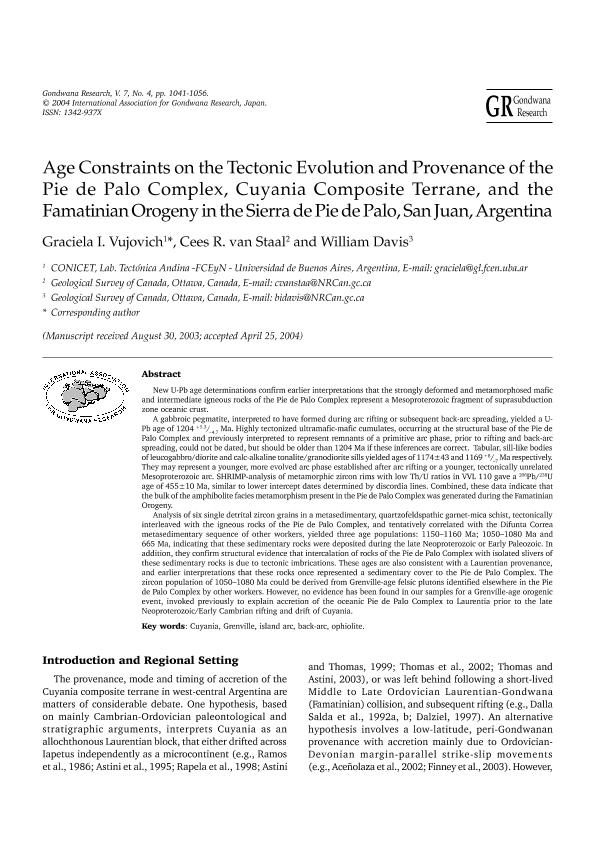Artículo
Age constraints on the tectonic evolution and provenance of the Pie de Palo Complex, Cuyania composite terrane and the Famatinian orogeny in the Sierra de Pie de Palo, San Juan, Argentina
Fecha de publicación:
12/2004
Editorial:
Elsevier Science
Revista:
Gondwana Research
ISSN:
1342-937X
Idioma:
Inglés
Tipo de recurso:
Artículo publicado
Clasificación temática:
Resumen
New U-Pb age determinations confirm earlier interpretations that the strongly deformed and metamorphosed mafic and intermediate igneous rocks of the Pie de Palo Complex represent a Mesoproterozoic fragment of suprasubduction zone oceanic crust. A gabbroic pegmatite, interpreted to have formed during arc rifting or subsequent back-arc spreading, yielded a U-Pb age of 1204 +5.3/-4. 7 Ma. Highly tectonized ultramafic-mafic cumulates, occurring at the structural base of the Pie de Palo Complex and previously interpreted to represent remnants of a primitive arc phase, prior to rifting and back-arc spreading, could not be dated, but should be older than 1204 Ma if these inferences are correct. Tabular, sill-like bodies of leucogabbro /diorite and calc-alkaline tonalite/granodiorite sills yielded ages of 1174±43 and 1169+1/-7 Ma respectively. They may represent a younger, more evolved arc phase established after arc rifting or a younger, tectonically unrelated Mesoproterozoic arc. SHRIMP-analysis of metamorphic zircon rims with low Th/U ratios in VVL 110 gave a 206Pb/238U age of 455 ± 10 Ma, similar to lower intercept dates determined by discordia lines. Combined, these data indicate that the bulk of the amphibolite facies metamorphism present in the Pie de Palo Complex was generated during the Famatinian Orogeny. Analysis of six single detrital zircon grains in a metasedimentary, quartzofeldspathic garnet-mica schist, tectonically interleaved with the igneous rocks of the Pie de Palo Complex, and tentatively correlated with the Difunta Correa metasedimentary sequence of other workers, yielded three age populations: 1150-1160 Ma; 1050-1080 Ma and 665 Ma, indicating that these sedimentary rocks were deposited during the late Neoproterozoic or Early Paleozoic. In addition, they confirm structural evidence that intercalation of rocks of the Pie de Palo Complex with isolated slivers of these sedimentary rocks is due to tectonic imbrications. These ages are also consistent with a Laurentian provenance, and earlier interpretations that these rocks once represented a sedimentary cover to the Pie de Palo Complex. The zircon population of 1050-1080 Ma could be derived from Grenville-age felsic plutons identified elsewhere in the Pie de Palo Complex by other workers. However, no evidence has been found in our samples for a Grenville-age orogenic event, invoked previously to explain accretion of the oceanic Pie de Palo Complex to Laurentia prior to the late Neoproterozoic/Early Cambrian rifting and drift of Cuyania.
Palabras clave:
BACK-ARC
,
CUYANIA
,
GRENVILLE
,
ISLAND ARC
,
OPHIOLITE
Archivos asociados
Licencia
Identificadores
Colecciones
Articulos(IDEAN)
Articulos de INSTITUTO DE ESTUDIOS ANDINOS "DON PABLO GROEBER"
Articulos de INSTITUTO DE ESTUDIOS ANDINOS "DON PABLO GROEBER"
Citación
Vujovich, Graciela Irene; van Staal, Cees R.; Davis, William; Age constraints on the tectonic evolution and provenance of the Pie de Palo Complex, Cuyania composite terrane and the Famatinian orogeny in the Sierra de Pie de Palo, San Juan, Argentina; Elsevier Science; Gondwana Research; 7; 4; 12-2004; 1041-1056
Compartir
Altmétricas




